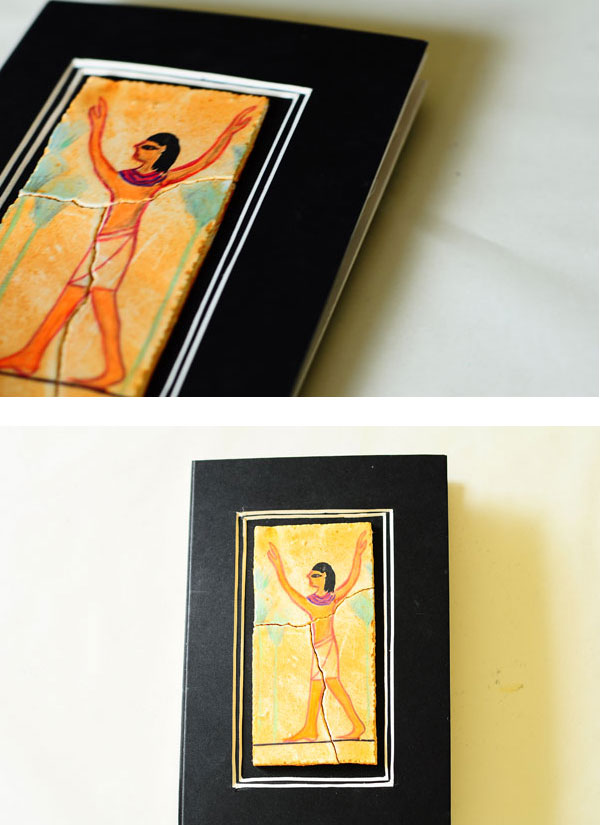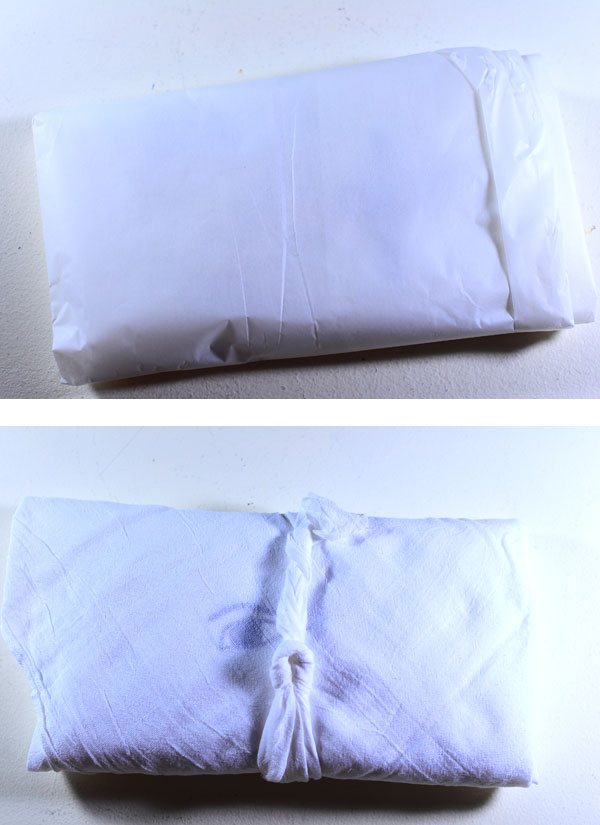The mechanisms depict first a dung beetle rolling a ball of dung and second a winged scarab lifted upward and forward on two rigid paper pillars. The background depicts Egyptian hieroglyphics that convey a birthday message along with a typical Egyptian warning. A separate hand-written document is included that transliterates the glyphs and translates them into English. A separate card is included within that document that makes clear the meaning of the cover, which is also a glyph.
The card as it is opened
The opened card
The card has no envelope, rather, it is wrapped in a preposterous length of thin paper with hieroglyphic amulets drawn on both sides of Bristol paper inserted between the folds. It is then further wrapped in a large thin cotton bar towel with more paper protective amulets between the cloth folds and finally belted with a strip of that same cloth and tied with a square knot.
Card wrappings and extraneous material.
Card wrapped.
The mechanisms took some time to work out and required several prototypes each. I kept making one mistake or another that prevented the mechanism from working or prevented them from folding flat. It took up to eight tries for each mechanism until I finally got something that worked reliably for both mechanisms. I went through a lot of card stock and Bristol paper for this card.
The principle of the dung beetle mechanism is the crimped corners of folded tab that is slightly elevated on the right side of the card and attached to the left half of the card at a 90˚ angle at that same elevation. The tab is elevated as a table when the card is in the 90˚ half opened position, and lays flat with the crimps spread wide open when the card is fully opened, and lays flat with the crimps pressed closed when the card is closed. This crimp closed to crimp opened creates a movement in the angle of the crimp as the card is opened that is exploited. It is a tiny crimp and a tiny angle and tiny spot of glue, but a decent movement that can be translated to a rotation with the use of a tiny arm. This was the tricky bit.
The following diagram depicts one of the crimps in the tab, there are actually two that face each other. The arms glued to the crimps, half of the crimp actually, move in opposite directions so the discs glued to the arms appear to rotate in opposite directions. With a dung ball drawn on one disc, and a beetle drawn on the other, and with the discs overlapping, it appears as if the beetle is rolling the ball.
The winged scarab is a tent atop a platform constructed on a plane horizontal to an opened card. It's lifted by two pillars that are attached on the cards central fold with a typical V mechanism. The V is centered with the central fold of the card and the two Vs are parallel with each other. They're unusually tall Vs and thin so they're more like pillars than regular V tabs to which content is attached. In this case they hold up a table that is loosely attached at the top with tabs rather than being glued. This is the bottom of the bug. When the card is opened the V tabs (pillars) flip up. Since they're parallel, they flip together. In the upright position the table that the pillars hold is flat with the base of the card. When the card is folded, the tab pillars dutifully fold back down dragging the table with it which is also forced closed in harmony with the card, as its fold and orientation is aligned with the card. After all this is established, a tent is designed to top the table which becomes the top of the bug, also with a fold aligned with the card's fold, but this time the fold is in the opposite direction. So whereas the bottom of the bug folds as the card folds, the top of the bug folds in the opposite direction, but it's still attached at the sides so it can not go anywhere. The legs of the bug are just a matter of extending the bottom of the bug. In this case, they're glued separately.
Wings are a different matter. They consist of another table mechanism with extraordinarily short legs. The table consists of three short posts one on the central fold and one on each each side, all three post are wide as the wing itself. The posts are shaped vaguely as an I-bar. The posts are attached to the upper side of the bottom of the bug. So the wings amounts to a table on a table set on two pillars, covered by a tent. A slot is provided on the top (the tent) of the bug to allow for flappy movement of the wings as they fold and unfold forced by attachment with the movement of the card.
This really isn't all that complicated, but it does take a bit of precision, which runs counter to my slap-dash tendencies.
The picture painted for the cover is the glyph for "rejoice," some read "praise."
The message inside the card reads:
"He who opens this card without giving good birthday praise and gladdening the heart, I will wring his neck like a bird."
There. That should ensure everybody at least says, "Happy Birthday" when they open the card. The thing that amuses me is the glyph for "birth" is a picture of a little baby dropping out of a seated woman. This is 100% of fact, although I'm fairly certain Egyptians didn't celebrate birthdays as we do today. Plus the idea of including an inactionable threat along with a birthday greeting just strikes me as funny.








No comments:
Post a Comment